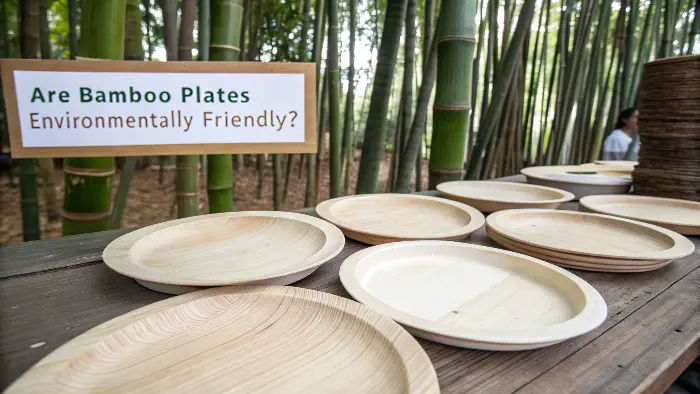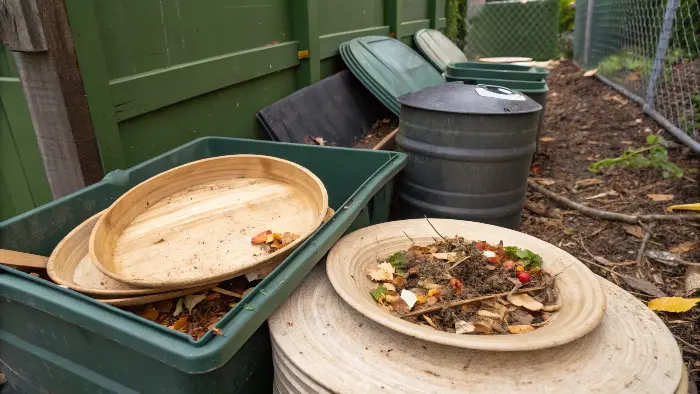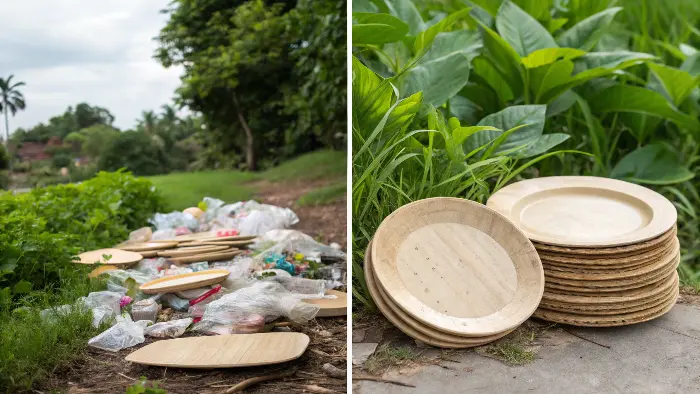Tired of greenwashing? Eco-friendly claims are everywhere, but which tableware truly helps our planet? Let’s find out the real story.
Bagasse often wins for overall sustainability – it’s a plant byproduct, composts quickly, and generally uses less energy to produce. Bamboo is also a fantastic, strong contender, while PLA has specific industrial composting needs that are important to know.
So, you’re looking for the real deal in sustainable tableware, right? It’s a big question, and honestly, the answer isn’t always cut and dried. But don’t worry! Let’s unpack this a bit more. Understanding the details can make all the difference for your business – and for the planet. I know when I first started exploring this for Ecosourcecn, it felt like a maze, but we’re here to help you navigate it.
Which disposable plates are best for the environment?
So many "green" plates out there! It’s genuinely tough choosing, isn’t it? You want the absolute best for your eco-conscious customers, but what does "best" even mean in this context?
Generally, plates made from plant-based, rapidly renewable resources like bagasse (from sugarcane) or bamboo are top choices. They biodegrade much better than plastic and often have a smaller manufacturing footprint, which is a big win!
| When we talk about "best," we’re looking at a few key things. Where does the material come from? How is it made? And what happens to it after use? At Ecosourcecn, we’ve spent years looking into this. My insight? Bagasse, which is made from sugarcane pulp—a byproduct of sugar production—is often a superstar. Think about it: we’re taking something that would otherwise be waste and turning it into something useful. It typically requires less energy to produce compared to PLA and even some other plant-based options. Plus, it composts beautifully, breaking down relatively quickly in the right conditions. Then there’s bamboo. What a plant! It grows incredibly fast and doesn’t usually need much help in terms of pesticides or fertilizers. This makes it a highly renewable resource. Bamboo products are sturdy and have a great natural look. PLA (Polylactic Acid) is another common one. It’s a bioplastic usually made from corn starch or sugarcane. PLA is cool because it can look and feel like traditional plastic, but it’s compostable. The catch? PLA often needs industrial composting facilities to break down properly. So, for folks like Jacky, our packaging specialist friend in Canada, knowing the local composting infrastructure is key when choosing PLA. It’s all about matching the product to the real-world disposal options. Here’s a quick look: |
Material | Source | Renewability | Composting Needs |
|---|---|---|---|---|
| Bagasse | Sugarcane | High | Home/Industrial | |
| Bamboo | Bamboo Grass | Very High | Home/Industrial | |
| PLA | Corn/Sugarcane | High | Industrial (typically) |
So, while bagasse often takes the lead for its all-around performance, bamboo is a very close second. Both are fantastic alternatives to traditional plastic.
Are bamboo plates environmentally friendly?
Bamboo seems like a miracle plant, right? It grows so fast! But the big question is: are products made from it, like plates, truly good for Mother Earth? Let’s look closer.
Yes, bamboo plates are generally very environmentally friendly. Bamboo itself is a champion of sustainability—it grows incredibly fast, often needs no pesticides, and the products biodegrade. However, the how of processing and sourcing really matters for its true eco-impact.

I’ve always been fascinated by bamboo. I remember visiting a sustainably managed bamboo forest a few years ago – it was incredible! The speed at which it regenerates is just mind-blowing. This rapid growth means it’s a highly renewable resource, much more so than trees used for paper products. It also means it can sequester a good amount of CO2. Plus, bamboo generally doesn’t require replanting after harvest; it just sprouts back up. And, as we mentioned, it usually thrives without needing nasty pesticides or fertilizers, which is great news for soil and water health.
Now, when we turn that bamboo into plates, the process matters. Most bamboo tableware is made by pressing layers of bamboo together or by molding bamboo pulp. It’s important to ensure that any adhesives or binders used are food-safe and don’t hinder biodegradability. At Ecosourcecn, we’re super careful about this. We work with suppliers who are transparent about their methods. The end product is typically very durable for a disposable item, yet it’s designed to break down naturally. So, compared to a plastic plate that sticks around for centuries, a bamboo plate that returns to the earth in months? That’s a huge win. It’s about the whole lifecycle, from the ground to your table, and back to the ground. Pretty neat, huh?
How long does it take for bamboo plates to decompose?
Okay, so bamboo plates are pretty eco-friendly when they’re made. But what happens after the picnic or the party? How fast do they really disappear back into the earth?
Untreated, natural bamboo plates can decompose in about 2 to 6 months in a commercial composting facility. In a home compost bin, it might take a bit longer, say 4 to 12 months, really depending on the conditions like moisture and heat.

This is a question we get a lot, especially from clients like Jacky who need to provide clear disposal information to their customers. And it’s a good one! The "how long" depends on a few things. Think of your compost pile as a tiny ecosystem. It needs the right ingredients: moisture, warmth, and a good mix of "greens" and "browns" to get those helpful microorganisms working hard. In a commercial composting facility, they control these conditions perfectly, so things break down super fast. We’re talking just a couple of months for bamboo.
In your backyard compost, it might take a little longer. Maybe closer to 6 months, or even up to a year if the conditions aren’t ideal. But here’s the amazing part: it does decompose. It returns to the soil, enriching it. Compare that to a plastic plate – scientists estimate those can take 400 years or more to break down, and even then, they just turn into microplastics. Yikes! So, even if it takes a few extra months in a home compost, bamboo is still leagues ahead. I once tried composting some of our Ecosourcecn bamboo samples in my own garden compost. I was so thrilled to see them breaking down and becoming part of the soil! It really brings the "sustainable cycle" to life.
Are bamboo plates better than plastic?
Plastic plates are cheap and everywhere, we all know that. But the planet pays a really high price for that convenience. So, is bamboo a clear winner in this fight against plastic?
Absolutely, yes! Bamboo plates are far, far better for the environment than plastic plates. They come from a renewable resource, don’t leach harmful chemicals into your food, and they biodegrade naturally. Plastic, on the other hand, pollutes for centuries.

Let’s break it down simply. First, where do they come from? Bamboo is a plant, a grass that grows super fast. Plastic? It’s mostly made from petroleum, a fossil fuel. Drilling for oil isn’t exactly great for the planet, right? Then think about making them. While all manufacturing has some impact, making plastic often involves more energy and releases more greenhouse gases.
And what about when you use them? Some plastics, especially when heated, can leach chemicals into your food. Bamboo doesn’t have that problem; it’s natural. I always feel a bit uneasy when I see food served on certain types of plastic, especially for kids. That’s a big reason why we at Ecosourcecn are so passionate about promoting alternatives like bamboo. It just feels safer, more wholesome.
But the biggest difference is the end-of-life story. A bamboo plate, once you’re done, can go into a compost bin and return to the earth. It becomes soil food! A plastic plate? It goes to a landfill where it sits for hundreds of years, or worse, ends up in our oceans, harming wildlife. It’s a no-brainer, really. Every time a business or a person chooses a bamboo plate over a plastic one, it’s a small victory for our planet. It might seem like a small switch, but when millions make it, wow, that adds up to a huge positive impact! 🔥
Conclusion
Choosing truly sustainable tableware like bagasse or bamboo makes a real difference. They are significantly better for our Earth than traditional plastic options. Small choices, big impact!


